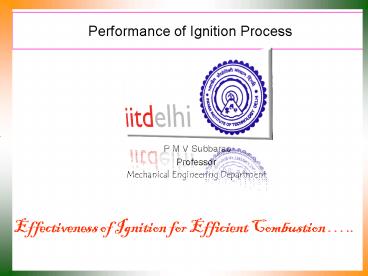Performance of Ignition Process - PowerPoint PPT Presentation
1 / 24
Title:
Performance of Ignition Process
Description:
Performance of Ignition Process P M V Subbarao Professor Mechanical Engineering Department Effectiveness of Ignition for Efficient Combustion .. The Efficiency of ... – PowerPoint PPT presentation
Number of Views:95
Avg rating:3.0/5.0
Title: Performance of Ignition Process
1
Performance of Ignition Process
- P M V Subbarao
- Professor
- Mechanical Engineering Department
Effectiveness of Ignition for Efficient
Combustion ..
2
The Efficiency of Coil
3
The Minimum Spark Energy
4
Minimum Spark Energy
- The minimum energy required to ignite a air-fuel
mixture . - Effect of Various Parameters on MIE
- Distance Between Electrodes
- Fuel
- Equivalence Ratio
- Initial Temperature
- Air Movement
- Any situation leading to unavailability of
required MSE will create missing
stroke/incomplete combustion stroke. - This will reduce the fuel economy of SI engines.
5
The effect of the spark plug gap on the brake
specific fuel consumption
6
The effect of spark energy on the brake specific
fuel consumption
7
Other Ignition systems
- Ignition By An Electrically Heated Wire
- Ignition By Flame or Hot Jet
- Plasma Jet Ignition
- Photochemical Ignition
- Microwave Ignition
- Laser Ignition
- Puff-jet Ignition
8
Laser Ignition
- The importance of the spark time scale on the
flame kernel size and NOx production is well
recongnized. - A laser ignition source has the potential of
improving engine combustion with respect to
conventional spark plugs. - A laser based ignition source, i.e. replacing the
spark plug by the focused beam of a pulsed laser. - Laser ignition, or laser-induced ignition, is the
process of starting combustion by the stimulus - of a laser light source.
- It was tried to control autoignition by a laser
light source. - The time scale of a laser-induced spark is by
several orders of magnitude smaller than the time
scales of turbulence and chemical kinetics.
9
The Concept of Laser Ignition
10
Arrangement and Control of Ingition Region
11
Phases in Laser Ignition
- The different phases of laser ignition can be
defined in chronological order - Electric breakdown and energy transfer from laser
to plasma - Shock-wave generation and propagation
- Gasdynamic effects
- Chemical induction of branching chain reactions
of radicals leading to ignition - Turbulent flame initiation
12
Time Scales in Laser Ignition
13
Selection of Wave Length
14
Effectiveness of Laser Ignition
15
Control of Ignition Region
16
Impact of Modern Methods on Engine Cycle
17
Impact of Modern Methods on Engine Cycle
18
Ignition to Combustion
Crank Angle,q
19
Initial phase of combustion
- Pictures of the initial phase of combustion show
an initially quasi-spherical, relatively smooth
flame kernel. - Thus, one can assume the initial combustion to
proceed in a quasi-laminar fashion, with the mass
burning rate given by
- Here, ru is the unburned gas density,
- A is the flame area defined at the cold flame
front, and - unr is the stretched laminar burning velocity
based on the rate of production of reacted gasof
the initial phase of combustion show an initially
quasi-spherical, relatively smooth flame kernel. - Thus, one can assume the initial combustion to
proceed in a quasi-laminar fashion, with the mass
burning rate given by
20
Flame Propagation Combustion in SI Engine
Flow
21
Phases in Flame Development
Flame development angle Dqd crank angle
interval during which flame kernal develops after
spark ignition. Rapid burning angle Dqb crank
angle required to burn most of mixture Overall
burning angle - sum of flame development and
rapid burning angles
Mass fraction burned
CA
22
Mixture Burn Time
B
Sl Laminar Flame velocity
How does the flame burn all the mixture in the
cylinder in the time available, especially at
high engine speeds?
It is impossible to build an engine which runs
more than 100 rpm with laminar flames !!!!
23
Laminar Flame Speed
- Laminar flames in premixed fuel, air, residual
gas mixture are characterized by laminar flame
speed Sl
fuel fm Bm(cm/s) Bf(cm/s)
Methonol 1.11 36.9 -140.5
Propane 1.08 34.2 -138.7
Isooctane 1.13 26.3 -84.7
Gasoline 1.21 30.5 -54.9
24
Need for Turbulent Flow
- High speed engines are possible only due to
turbulent combustion. - The turbulent flow field in an engine plays
important role in determining its combustion
characteristics and thermal efficiency. - Automotive engineers have learned that changes
in the combustion chamber shape and inlet system
geometry, both of which change the turbulent flow
field, influence emissions, fuel economy and the
lean operating limit of an engine. - Most of this knowledge has been obtained on
specific engines through direct experimentation
or from global measurements. - As it result there exist no general scaling laws
to predict the combustion and emission
characteristics of an engine.































